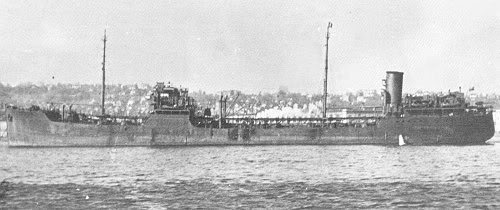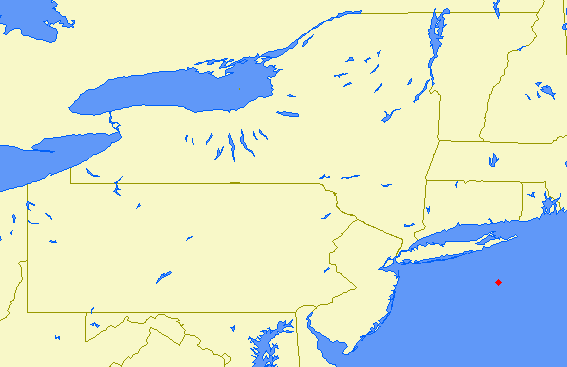Auke Visser's MOBIL Tankers & Tugs Site | home
Coimbra - (1937-1942)

SS "Coimbra".

Type: tanker, England
Name: Coimbra is an important city and university in east-central Portugal.
Whether there is a connection, I don't know.
Built: 1937, Germany Specs: ( 423 x 60 ft ) 6768 gross tons, 40 crew
Sunk: Thursday January 15, 1942
torpedoed by U-123 - 34 casualties Depth: 190 ft, starts at 165 ft
Coimbra
LOA 433'6", Beam 60', Depth 33', 10,121 DWT, 81,259 bbls
Lentz double compound engine 47.25" stroke 2800 IHP.
Launched 20 May and commissioned 6 July 1937 at Howaldstwerke AG, Kiel, Germany.
COIMBRA, the second British-flag ship to bear the name, began making voyages on the British Admiralty’s account almost immediately after the outbreak of WWII but was not fully requisitioned until January 1941. She then served in the North Atlantic as a lube-oil carrier from the US to the UK until the Germans launched their U-boat campaign in American home waters by sinking two merchant vessels off the shore of Long Island in January 1942. The first victim was the Norwegian vessel NORNESS. The second was COIMBRA.
COIMBRA was proceeding eastwards, with New York only 10 hours behind her. The first torpedo hit forward of the engine-room, and Captain J.P. Bernard turned COIMBRA around and headed back for New York. Ten minutes later, however, a second torpedo struck on the starboard side. The cargo caught fire and the ship began to settle fast by the stern. The submarine surfaced and turned an orange searchlight on the ship and survivors, but took no other action against them.
The night was bitterly cold, and nine of those lost, including Captain Bernard, perished of exposure in a swamped lifeboat before being picked up by the USS ROWAN 12 hours later. There were only 10 survivors out of a crew of 46.
Attempts were made to salvage COIMBRA. Salvage tugs found her listing at about 48°, scraping her stern along the bottom with her bow still pointing skyward above the surface. Salvage proved impossible, and COIMBRA was eventually abandoned, 19 miles from Shinnecock Light.
The last photograph of COIMBRA was taken by pilots of the First Air Force operating out of Mitchell Field. It shows 30' of her bow and a portion of her foremast out of the water, and an oil slick running away to leeward. This photograph was published in Life (2 February 1942).
|
Additional Info by Starke & Schell Registers :
COIMBRA - 1937 BR 1C(d) (aft) (11)
6,768 GRT for Standard Transportation Co., Ltd., London 422.8 x 60.4
Tanker build by Howaldtswerke, A.G., Kiel (7) #756 165498
1940 - Socony-Vacuum Transportation Co., Ltd., London
Torpedoed and sunk by U 123, on 15 Jan 1942, in 40.25N-72.21W,
voyage New York - West coast of U.K., lubricating oil.
The Miramar Ship Index for "COIMBRA"
IDNo:
|
1165498
|
Year:
|
1937
|
Name:
|
COIMBRA
|
Keel:
|
|
Type:
|
Tanker
|
Launch Date:
|
20.05.1937
|
Flag:
|
GBR
|
Date of completion:
|
07.1937
|
Tons:
|
6768
|
Link:
|
-
|
DWT:
|
Yard No:
|
756
|
|
Length overall:
|
Ship Design:
|
||
LPP:
|
128.9
|
Country of build:
|
DEU
|
Beam:
|
18.4
|
Builder:
|
Howaldtswerke
|
Material of build:
|
Location of yard:
|
Kiel
|
|
Number of screws/Mchy/Speed(kn):
|
1C-11
|
||
Subsequent History:
-
Disposal Data:
Torpedoed and sunk by U-123 at 40.25 N / 72.21 W on 15.01.1942 (36 dead)
History:
ON
|
LR/IMO
|
ID
|
Year
|
Name
|
Tons
|
Change
|
Registered Owner
|
165498
|
1165498
|
1937
|
COIMBRA
|
6768
|
Standard Tptn Co.
|
Additional information from Uboat.net :
Name: Coimbra
Type: Steam tanker
Tonnage: 6.768 tons
Completed: 1937 - Howaldtswerke AG, Kiel
Owner: Socony Vacuum Transportation Co Ltd, Montreal
Homeport: London
Date of attack: 15 Jan, 1942
Nationality: British
Fate: Sunk by U-123 (Reinhard Hardegen)
Position: 40.25N, 72.21W - Grid CA 2896
- See location on a map -

Complement: 46 (36 dead and 10 survivors).
Convoy: -
Route: New York - UK
Cargo: 9000 tons of lubricating oil
History: Standard Transportation Co Ltd, Hong Kong
Notes on loss: At 09.41 hours on 15 Jan, 1942, the unescorted Coimbra (Master John Patrick Barnard) was hit by one
torpedo from U-123, which had spotted the lights of the tanker astern while the U-boat was proceeding eastbound following
the southern shore of Long Island. The torpedo struck on the starboard side just aft of the superstructure. A huge towering
explosion lit up the night sky and the cargo of oil quickly caught fire and spread across the water. Residents from the
Hamptons on Long Island could see the fire at sea 27 miles away and alerted the authorities. A second torpedo hit the
tanker and her stern immediately sank, striking the sea floor. Like his previous victim, the Norness, the bow of the
Coimbra was sticking out of the water. Hardegen suggested that, it was a good thing that my wrecks were partly sticking
out of the water. Otherwise how would other ships find the harbor?. The tanker later sank completely.
The master, 29 crew members and six gunners were lost. Ten survivors, six of them wounded were rescued from the rough
seas. Two crew members were picked up by the American destroyer USS Rowan (DD 405) and landed at Argentia,
Newfoundland. The remaining survivors were rescued by another American destroyer and landed at St.Johns.